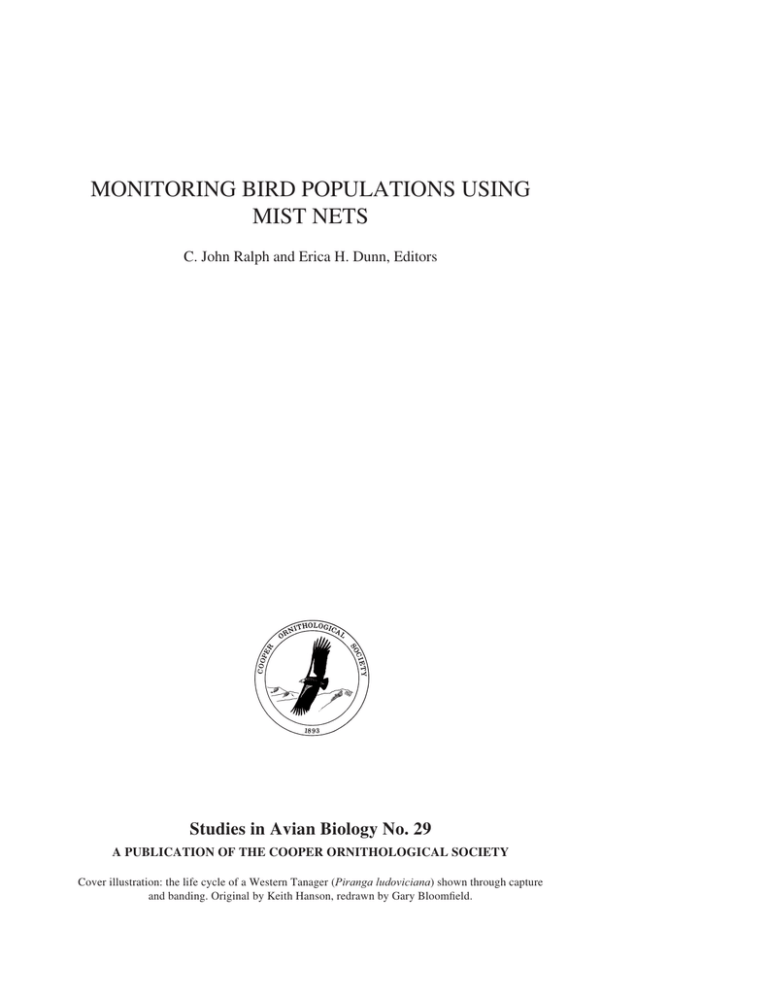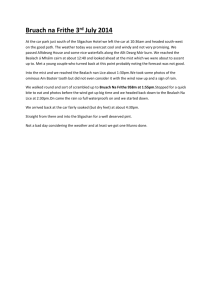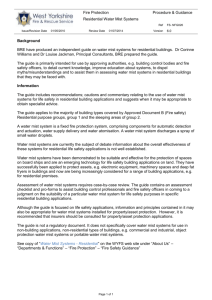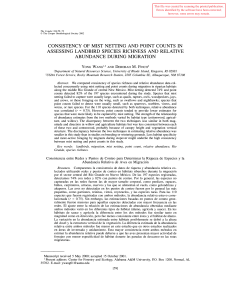MONITORING BIRD POPULATIONS USING MIST NETS Studies in Avian Biology No. 29
advertisement

MONITORING BIRD POPULATIONS USING MIST NETS C. John Ralph and Erica H. Dunn, Editors Studies in Avian Biology No. 29 A PUBLICATION OF THE COOPER ORNITHOLOGICAL SOCIETY Cover illustration: the life cycle of a Western Tanager (Piranga ludoviciana) shown through capture and banding. Original by Keith Hanson, redrawn by Gary Bloomfield. STUDIES IN AVIAN BIOLOGY Edited by John T. Rotenberry Department of Biology University of California Riverside, CA 92521 Studies in Avian Biology is a series of works too long for The Condor, published at irregular intervals by the Cooper Ornithological Society. Manuscripts for consideration should be submitted to the editor. Style and format should follow those of previous issues. Price $23.00 including postage and handling. All orders cash in advance; make checks payable to Cooper Ornithological Society. Send orders to Cooper Ornithological Society, c/o Western Foundation of Vertebrate Zoology, 439 Calle San Pablo, Camarillo, CA 93010. ISBN: 0-943610-61-3 Library of Congress Control Number: 2004111015 Printed at Cadmus Professional Communications, Ephrata, Pennsylvania 17522 Issued: 8 December 2004 Copyright © by the Cooper Ornithological Society 2004 CONTENTS LIST OF AUTHORS ............................................................................................................ v–vi PREFACE ........................................................................................................................... vii INTRODUCTION Use of mist nets as a tool for bird population monitoring ..................................................... ...................................................................................... Erica H. Dunn and C. John Ralph 1 BREEDING SEASON EVALUATIONS Effects of mist-netting frequency on capture rates at Monitoring Avian Productivity and Survivorship (MAPS) stations ................ Kenneth M. Burton and David F. DeSante 7 Monitoring productivity with multiple mist-net stations ...................................................... .................................................. C. John Ralph, Kimberly Hollinger, and Sherri L. Miller 12 Influence of mist-netting intensity on demographic investigations of avian populations ..........................................................Grant Ballard, Geoffrey R. Geupel, and Nadav Nur 21 Methodological considerations of the Monitoring Avian Productivity and Survivorship (MAPS) Program ................. David F. DeSante, James F. Saracco, Danielle R. O’Grady, Kenneth M. Burton, and Brett L. Walker 28 Current practices in the British Trust for Ornithology Constant Effort Sites scheme and comparisons of temporal changes in mist-net captures with changes in spot-mapping counts at the extensive scale ............................................................................................. .............................................. Will J. Peach, Stephen R. Baillie, and Stephen T. Buckland 46 Relationship of juveniles captured in constant-effort netting with local abundance ......................................................................... Chris R. du Feu and John M. McMeeking 57 Estimates of adult survival, capture probability, and recapture probability: evaluating and validating constant-effort mist netting ....................................................................... .......................................................... Nadav Nur, Geoffrey R. Geupel, and Grant Ballard 63 Estimating adult survival rates from between-year recaptures in the British Trust for Ornithology Constant Effort Sites scheme ............... Will J. Peach and Stephen R. Baillie 71 EVALUATION OF MIST NETTING OUTSIDE THE BREEDING SEASON A European example of standardized mist netting in population studies of birds ................................................................................... Andreas Kaiser and Peter Berthold 75 Determining productivity indices from age composition of migrants captured for banding: problems and possible solutions ......................................... David J. T. Hussell 82 An investigation of productivity indices derived from banding of fall migrants ............................. Erica H. Dunn, David J. T. Hussell, and Raymond J. Adams 92 Optimizing the allocation of count days in a migration monitoring program .................................... Len Thomas, Geoffrey R. Geupel, Nadav Nur, and Grant Ballard 97 Use of mist nets for monitoring landbird autumn population trends, and comparison with other methods ................................................................................... Peter Berthold 112 A comparison of three count methods for monitoring songbird abundance during spring migration: capture, census, and estimated totals ............................................................... .............. Erica H. Dunn, David J. T. Hussell, Charles M. Francis, and Jon D. McCracken 116 A comparison of constant-effort mist netting results at a coastal and inland New England site during migration ......................................................................................................... Christopher C. Rimmer, Steven D. Faccio, Trevor L. Lloyd-Evans, and John M. Hagan, III 123 Mist netting trans-Gulf migrants at coastal stopover sites: the influence of spatial and temporal variability on capture data ................................................................................. .................................... Theodore R. Simons, Frank R. Moore, and Sidney A. Gauthreaux 135 Bird population studies in Puerto Rico using mist nets: general patterns and comparisons with point counts ........................ John Faaborg, Wayne J. Arendt, and Katie M. Dugger 144 Coping with mist-net capture-rate bias: canopy height and several extrinsic factors ............................................ Elizabeth P. Mallory, Nicholas Brokaw, and Steven C. Hess 151 Use of mist nets for study of neotropical bird communities ............... Andrew A. Whitman 161 GENERAL CONSIDERATIONS Some consequences of using counts of birds banded as indices to populations ............................................................... John R. Sauer and William A. Link 168 On the use of capture–recapture models in mist-net studies ................................................. William L. Kendall, John R. Sauer, James D. Nichols, Roger Pradel, and James E. Hines 173 Effectiveness of informal banding training at three western Canadian banding stations ..................................................................................................... Brenda C. Dale 182 RECOMMENDATIONS Recommendations for the use of mist nets for inventory and monitoring of bird populations .......... C. John Ralph, Erica H. Dunn, Will J. Peach, and Colleen M. Handel 187 LITERATURE CITED ......................................................................................................... 197







